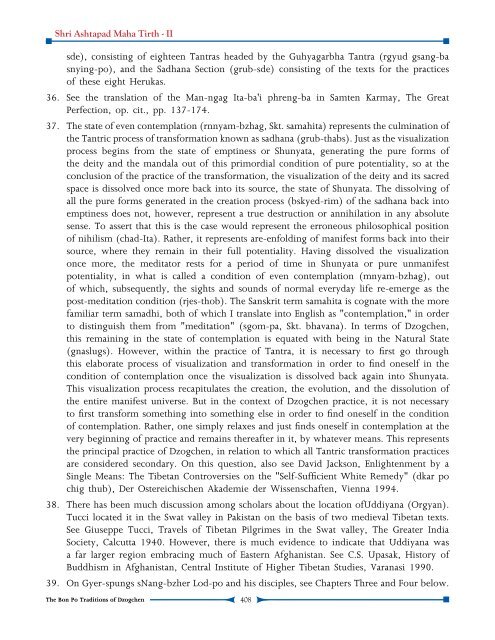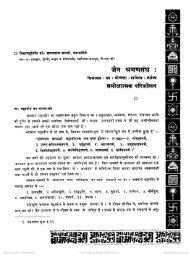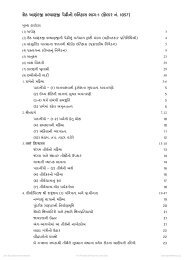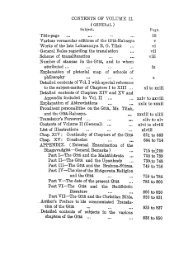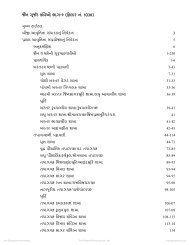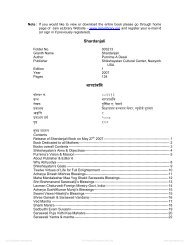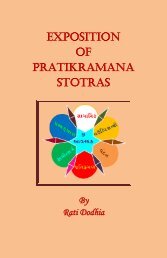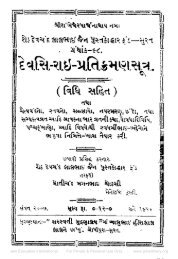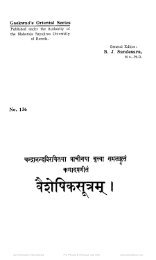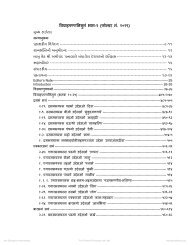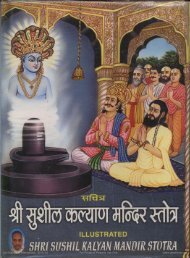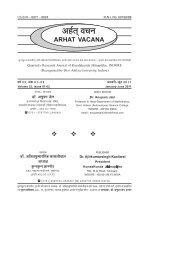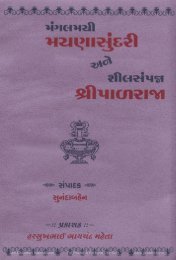Chapter - 08 Bon Po Religion - Jain Library
Chapter - 08 Bon Po Religion - Jain Library
Chapter - 08 Bon Po Religion - Jain Library
You also want an ePaper? Increase the reach of your titles
YUMPU automatically turns print PDFs into web optimized ePapers that Google loves.
Shri Ashtapad Maha Tirth - II<br />
sde), consisting of eighteen Tantras headed by the Guhyagarbha Tantra (rgyud gsang-ba<br />
snying-po), and the Sadhana Section (grub-sde) consisting of the texts for the practices<br />
of these eight Herukas.<br />
36. See the translation of the Man-ngag Ita-ba'i phreng-ba in Samten Karmay, The Great<br />
Perfection, op. cit., pp. 137-174.<br />
37. The state of even contemplation (rnnyam-bzhag, Skt. samahita) represents the culmination of<br />
the Tantric process of transformation known as sadhana (grub-thabs). Just as the visualization<br />
process begins from the state of emptiness or Shunyata, generating the pure forms of<br />
the deity and the mandala out of this primordial condition of pure potentiality, so at the<br />
conclusion of the practice of the transformation, the visualization of the deity and its sacred<br />
space is dissolved once more back into its source, the state of Shunyata. The dissolving of<br />
all the pure forms generated in the creation process (bskyed-rim) of the sadhana back into<br />
emptiness does not, however, represent a true destruction or annihilation in any absolute<br />
sense. To assert that this is the case would represent the erroneous philosophical position<br />
of nihilism (chad-Ita). Rather, it represents are-enfolding of manifest forms back into their<br />
source, where they remain in their full potentiality. Having dissolved the visualization<br />
once more, the meditator rests for a period of time in Shunyata or pure unmanifest<br />
potentiality, in what is called a condition of even contemplation (mnyam-bzhag), out<br />
of which, subsequently, the sights and sounds of normal everyday life re-emerge as the<br />
post-meditation condition (rjes-thob). The Sanskrit term samahita is cognate with the more<br />
familiar term samadhi, both of which I translate into English as "contemplation," in order<br />
to distinguish them from "meditation" (sgom-pa, Skt. bhavana). In terms of Dzogchen,<br />
this remaining in the state of contemplation is equated with being in the Natural State<br />
(gnaslugs). However, within the practice of Tantra, it is necessary to first go through<br />
this elaborate process of visualization and transformation in order to find oneself in the<br />
condition of contemplation once the visualization is dissolved back again into Shunyata.<br />
This visualization process recapitulates the creation, the evolution, and the dissolution of<br />
the entire manifest universe. But in the context of Dzogchen practice, it is not necessary<br />
to first transform something into something else in order to find oneself in the condition<br />
of contemplation. Rather, one simply relaxes and just finds oneself in contemplation at the<br />
very beginning of practice and remains thereafter in it, by whatever means. This represents<br />
the principal practice of Dzogchen, in relation to which all Tantric transformation practices<br />
are considered secondary. On this question, also see David Jackson, Enlightenment by a<br />
Single Means: The Tibetan Controversies on the "Self-Sufficient White Remedy" (dkar po<br />
chig thub), Der Ostereichischen Akademie der Wissenschaften, Vienna 1994.<br />
38. There has been much discussion among scholars about the location ofUddiyana (Orgyan).<br />
Tucci located it in the Swat valley in Pakistan on the basis of two medieval Tibetan texts.<br />
See Giuseppe Tucci, Travels of Tibetan Pilgrimes in the Swat valley, The Greater India<br />
Society, Calcutta 1940. However, there is much evidence to indicate that Uddiyana was<br />
a far larger region embracing much of Eastern Afghanistan. See C.S. Upasak, History of<br />
Buddhism in Afghanistan, Central Institute of Higher Tibetan Studies, Varanasi 1990.<br />
39. On Gyer-spungs sNang-bzher Lod-po and his disciples, see <strong>Chapter</strong>s Three and Four below.<br />
The <strong>Bon</strong> <strong>Po</strong> Traditions of Dzogchen<br />
4<strong>08</strong>


